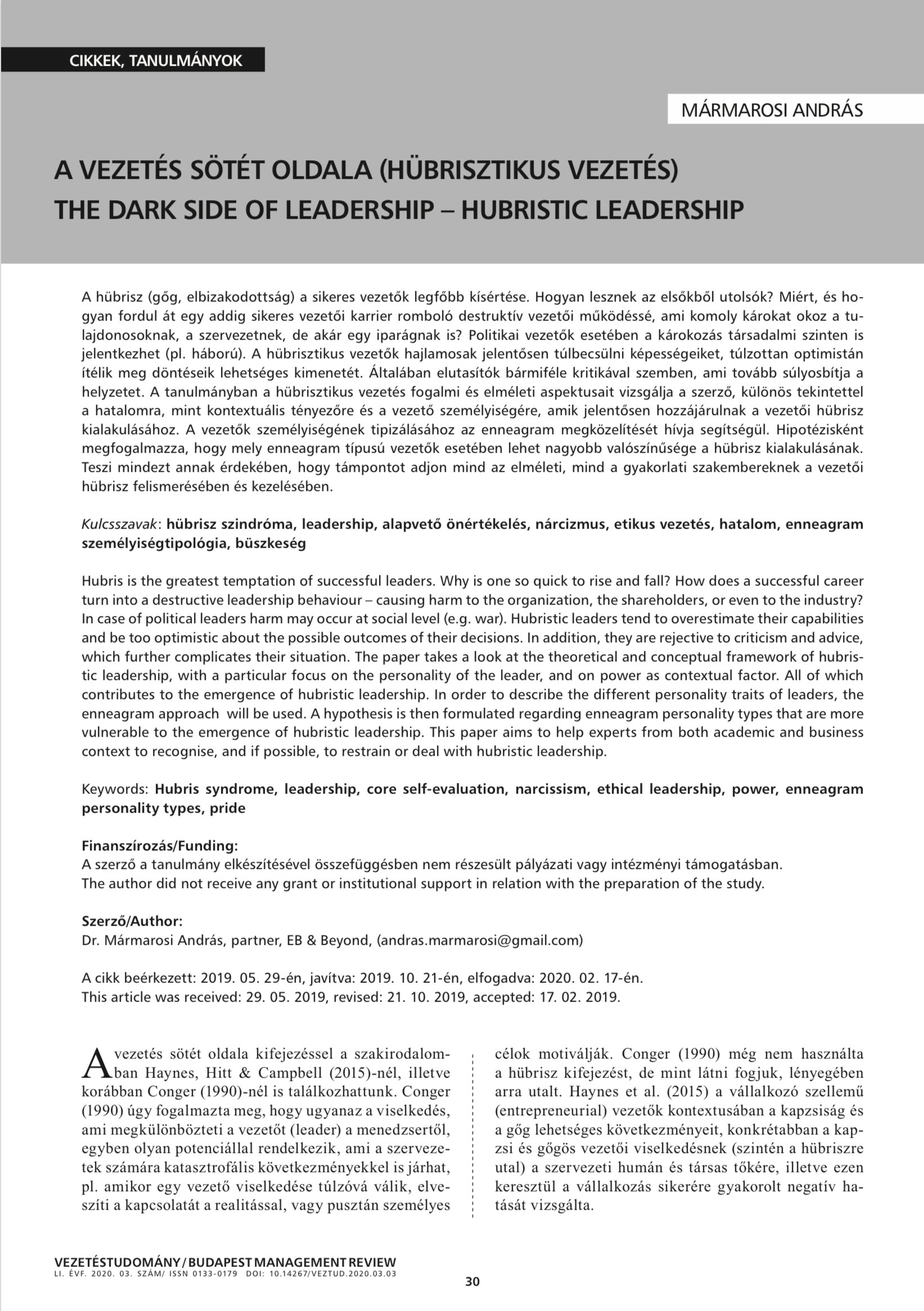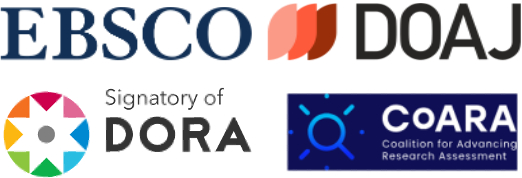A vezetés sötét oldala (hübrisztikus vezetés)
DOI:
https://doi.org/10.14267/VEZTUD.2020.03.03Kulcsszavak:
hübrisz szindróma, leadership, alapvető önértékelés, nárcizmus, etikus vezetés, hatalom, személyiségtipológia, büszkeség, enneagramAbsztrakt
A hübrisz (gőg, elbizakodottság) a sikeres vezetők legfőbb kísértése. Hogyan lesznek az elsőkből utolsók? Miért, és hogyan fordul át egy addig sikeres vezetői karrier romboló destruktív vezetői működéssé, ami komoly károkat okoz a tulajdonosoknak, a szervezetnek, de akár egy iparágnak is? Politikai vezetők esetében a károkozás társadalmi szinten is jelentkezhet (pl. háború). A hübrisztikus vezetők hajlamosak jelentősen túlbecsülni képességeiket, túlzottan optimistán ítélik meg döntéseik lehetséges kimenetét. Általában elutasítók bármiféle kritikával szemben, ami tovább súlyosbítja a helyzetet. A tanulmányban a hübrisztikus vezetés fogalmi és elméleti aspektusait vizsgálja a szerző, különös tekintettel a hatalomra, mint kontextuális tényezőre és a vezető személyiségére, amik jelentősen hozzájárulnak a vezetői hübrisz kialakulásához. A vezetők személyiségének tipizálásához az enneagram megközelítését hívja segítségül. Hipotézisként megfogalmazza, hogy mely enneagram típusú vezetők esetében lehet nagyobb valószínűsége a hübrisz kialakulásának. Teszi mindezt annak érdekében, hogy támpontot adjon mind az elméleti, mind a gyakorlati szakembereknek a vezetői hübrisz felismerésében és kezelésében.
Letöltések
Hivatkozások
American Psychiatric Association (2013). Diagnostic and Statistical Manual of Mental Disorders (Fifth Edition). Arlington, VA: American Psychiatric Association.
Alicke, M.D., Klotz, M.L., Breitenbecher, D.L., Yurak, T.J, & Vredenburg, D.S. (1995). Personal contact, individuation, and the better-than-average effect. Journal of Personality and Social Psychology, 68(5), 804–825. https://doi.org/10.1037/0022-3514.68.5.804
Bakacsi Gy. (2019). A karizmatikus és a neokarizmatikus leadership összehasonlítása. Vezetéstudomány, 50(3), 50-61. https://doi.org/10.14267/VEZTUD.2019.03.05
Bakacsi Gy. (2015). Változó vezetési paradigma – változó megbízó-ügynök probléma? In Bakacsi Gy. & Balaton K. (szerk.), Vezetés és szervezet társadalmi kontextusban: Tanulmányok Dobák Miklós 60. születésnapja tiszteletére (pp. 29-54). Budapest: Akadémiai Kiadó.
Bencsik A., Machova R., Juhász T., & Csókás L., (2018). Vezető/Leader versus Etika, avagy az etikus leaderi magatartás jellemzői. Vezetéstudomány, 49(10-11), 93- 104. https://doi.org/10.14267/VEZTUD.2018.10.09
Bland, A.M. (2011). The Enneagram: A Review of the Empirical and Transformational Literature. The Journal of Humanistic Counseling, Education and Development, 49(1), 16-31. https://doi.org/10.1002/j.2161-1939.2010.tb00084.x
Blaug, R. (2016). Pathologies of power and cognition. In Garrard, P. & Robinson, G. (Eds.), The Intoxication of Power: Interdisciplinary Perspectives (pp. 75-88). London, UK: Palgrave Macmillan. https://doi.org/10.1057/9781137439666
Bokor A., Szőcs-Kovács K., Csillag S., Bácsi K., & Szilas R. (2009). Emberi Erőforrás Menedzsment. Budapest: Aula Kiadó.
Brennan, N.M. & Conroy, J.P. (2013). Executive hubris: the case of a bank CEO. Accounting, Auditing & Accountability Journal, 26(2), 1 72-195. h ttps://doi.org/10.1108/09513571311303701
Brown, M.E., Trevino, L.K., & Harrison, D.A. (2005). Ethical leadership: A social learning perspective for construct development and testing. Organizational Behaviour and Human Decision Process, 97(2), 117-134. https://doi.org/10.1016/j.obhdp.2005.03.002
Campbell, W.K., Hoffman, B.J., Campbell, S.M., & Marchisio, G. (2011). Narcissism in organizational contexts. Human Resource Management Review, 21(4), 268-284. https://doi.org/10.1016/j.hrmr.2010.10.007
Chance, J. (2001). Lord of the Rings: The Mythology of Power. Lexington: University Press of Kentucky.
Chinen, A. B. (1996). The emergence of transpersonal psychiatry. In Scotton, B.W., Chinen, A.B., & Battista, J.R. (Eds.), Textbook of transpersonal psychiatry and psychology (pp. 9 –18). N ew York, US: Basic Books.
Claxton, G., Owen, D., & Sadler-Smith, E. (2014). Hubris in Leadership: A peril of unbridled intuition? Leadership, 11(1), 57-78. https://doi.org/10.1177/1742715013511482
Conger, J. A. (1990). The dark side of leadership. Organizational Dynamics, 19(2), 44-55. https://doi.org/10.1016/0090-2616(90)90070-6
Crossan, M., Mazutis, D., & Seijts, G. (2013). In search of virtue: The role of virtues, values and character strengths in ethical decision making. Journal of Business Ethics, 113(4), 567–581. https://doi.org/10.1007/s10551-013-1680-8
Daróczi J., Vágány J., & Fenyvesi É. (2016). Fejlődünk, hogy fejlődhessünk? Vezetéstudomány, 47(2), 72-82. https://doi.org/10.14267/VEZTUD.2016.12.07
Dinh, E.J., Lord, R.G., Gardner, W.L., & Meuser, J.D. (2014). Leadership theory and research in the new millenium: Current theoretical trends and changing perspectives. The Leadership Quarterly, 25(1), 36-62. https://doi.org/10.1016/j.leaqua.2013.11.005
Dowling, M., & Lucey, B.M. (2014). From hubris to nemesis: Irish banks, behavioural biases and the crises. Journal of Risk Management, 7(2), 122-133.
Drew, G.M. (2010). Enabling or “real” power and influence in leadership. Journal of Leadership Studies, 4(1), 47-58. https://doi.org/10.1002/jls.20154
Garrard, P. (2016). On the Linguistics of Power (and the Power of Linguistics). In Garrard, P., & Robinson, G. (Eds.), The Intoxication of Power: Interdisciplinary Perspectives (pp. 135-154). London, UK: Palgrave Macmillan. https://doi.org/10.1057/9781137439666
Ghaemi, S.N., Liapis, C., & Owen, D. (2016). Psychopathology of Power. In Garrard, P., & Robinson, G. (Eds.), The Intoxication of Power: Interdisciplinary Perspectives (pp. 17-37). London, UK: Palgrave Macmillan. https://doi.org/10.1057/9781137439666
Lapid-Bogda, G. (2007). What type of Leader are you? New York (NY): McGraw-Hill.
Goel, A.M., & Thakor, A.V. (2008). Overconfidence, CEO selection, and corporate governance. The Journal of Finance, 63(6), 2737-2784. https://doi.org/10.1111/j.1540-6261.2008.01412.x
Hayes, C. (2018). What your Enneagram type says about your Leadership style? Forbes, June. Retrieved from https://www.forbes.com/sites/forbescoachescou ncil /2018/06/15/what-you renneagram-type-says-about-your-leadershipstyle/#d96e43b3ed49
Haynes, K.T., Hitt, M.A., & Campbell, J.T. (2015). The dark side of leadership: Towards a mid-range theory of hubris and greed in entrepreneurial contexts. Journal of Management Studies, 52(4), 4 79-505. h ttps://doi.org/10.1111/joms.12127
Hayward, M.L.A. (2007). Ego check: Why Executive Hubris is Wrecking Companies and Careers and How to Avoid the Trap. Wokingham: Kaplan Publishing.
Hayward, M.L.A., & Hambrick, D.C. (1997). Explaining the premium paid for large acquisitions: Evidence of CEO hubris. Administrative Science Quarterly, 42(1), 103-127. https://doi.org/10.2307/2393810
Hernandez, M., Eberly, M.B., Avolio, B.J., & Johnson, M.D. (2011). The loci and mechanisms of leadership: Exploring a more comprehensive view of leadership theory. The Leadership Quarterly, 22(6), 1165-1185. https://doi.org/10.1016/j.leaqua.2011.09.009
Hiller, N.J., & Hambrick, D.C. (2005). Conceptualizing executive hubris: the role of (hyper) core selfevaluations in strategic decision-making. Strategic Management Journal, 26(4), 297-319. https://doi.org/10.1002/smj.455
Holley, F.R. (2014). The Diathesis-Stress Model of Corruption by the Ruling Ring: Nature, Power, and Exposure in J. R. R. Tolkien’s The Lord of the Rings. Student Scholarship, 3. Retrieved from: http://digitalcommons.wofford.edu/studentpubs/3
Hoogenboezem, J. (2007). Brinkmanship and Beyond: The Political Leadership of Franklin D. Roosevelt. Leadership, 3(2), 131-148. https://doi.org/10.1177/1742715007076211
Howell, J.M., & Avolio, B.J. (1992). The ethics of charismatic leadership: submission or liberation? Academy of Management Executive, 6(2), 43–54. https://doi.org/10.5465/ame.1992.4274395
Ingram, R. E., & Luxton, D. D. (2005). Vulnerability-Stress Models. In Hankin, B.L., & Abela, J.R.Z. (Eds.), Development of Psychopathology: A vulnerability stress perspective (pp. 32-46). Thousand Oaks, CA: Sage Publications Inc.
Isikoff, M., & Corn, D. (2006). Hubris: The Inside Story of Spin, Scandal, and the Selling of the Iraq War. New York, US: Crown Publishing.
Judge, T. A., & Bono, J.E. (2001). Relationship of Core Self-Evaluations Traits – Self-Esteem, Generalized Self-Efficacy, Locus of Control, and Emotional Stability – With Job Satisfaction and Job Performance: A Meta-Analysis. Journal of Applied Psychology, 86(1), 80-92. https://doi.org/10.1037//0021-9010.86.1.80
Kale, S.H., & Shrivastava, S. (2003). The enneagram system for enhancing workplace spirituality. Journal of Management Development, 22(4), 308-328. https://doi.org/10.1108/02621710310467596
Karácsonyi, A. (2006). A leadership, a szervezeti kultúra és kapcsolatuk jellegzetességei a magyar szervezetek esetében (PhD-értekezés). Budapest: Budapesti Corvinus Egyetem.
Kets de Vries, M. (2003). Doing an Alexander: Lessons on leadership by a master conqueror. European Management Journal, 21(3), 370-375. https://doi.org/10.1016/S0263-2373(03)00044-6
Kets de Vries, M. (2009). Sex, Money, Happiness, and Death: The Quest for Authenticity. London, UK: Palgrave Macmillan. https://doi.org/10.1007/978-0-230-24036-0
Kets de Vries, M.F.R., & Miller, D. (1985). Narcissism and leadership: An object relations perspective. Human Relations, 38(6), 583-601. https://doi.org/10.1177/001872678503800606
Ladd, A.E. (2012). Pandora's Well: Hubris, Deregulation, fossil fuels, and the BP oil disaster in the Gulf. American Behavioural Scientist, 56(1), 104-127. https://doi.org/10.1177/0002764211409195
Littleton, C.S. (2005). Gods, goddesses, and mythology. New York, US: Marshall Cavendish.
Malmendier, U., & Tate, G. (2005). Does overconfidence affect corporate investment? CEO overconfidence measures revisited. European Financial Management, 11(5), 649-659. https://doi.org/10.1111/j.1354-7798.2005.00302.x
Murray, O. (1990). The Solonian law of hubris. In Cartledge, P., Millett, P., & Todd, S. (Eds.), Nomos. Essays in Athenian Law, Politics and Society. Cambridge, UK:Cambridge University Press.
Salzwedel, M., & Tödter, U. (2008). Führen ist Charaktersache. Berlin: Cornelsen Verlag.
Mason, R.O. (2004). Lessons in organisational ethics from the Columbia disaster: Can a culture be lethal? Organizational Dynamics, 33(2), 128-142. https://doi.org/10.1016/j.orgdyn.2004.01.002
Mellahi, K. (2005). The dynamics of boards of directors in failing organizations. Long Range Planning, 38(3), 261-279. https://doi.org/10.1016/j.lrp.2005.04.001
Mudra L. (2001). Gondolatok a karizmatikus vezetésről. Vezetéstudomány, 32(6), 56-60.
Newgent, R.A., Parr, P.H., Newman, I., & Wiggins, K.K. (2004). The Riso-Hudson Enneagram Type Indicator: Estimates of Reliability and Validity. Measurement and Evaluation in Counseling and Development, 36(4), 226-237. https://doi.org/10.1080/07481756.2004.11909744
Owen, D. (2006). Hubris and nemesis in heads of government. Journal of the Royal Society of Medicine, 99(11), 548-551. https://doi.org/10.1258/jrsm.99.11.548
Owen, D. (2008). Hubris syndrome. Clinical Medicine, 8(4), 428-432. https://doi.org/10.7861/clinmedicine.8-4-428
Owen, D. (2012). The Hubris Syndrome: Bush, Blair and the Intoxication of Power (2nd Edition). York, UK: Methuen.
Owen, D., & Davidson, J. (2009). Hubris syndrome: an acquired personality disorder? A study of US Presidents and UK Prime Ministers over the last 100 years. Brain, 132(5), 1396–1406. https://doi.org/10.1093/brain/awp008
Palmer, H. (2015). Enneagram a szerelemben és a munkában. Budapest: Ursus Libris. Picone, P.M., Dagnino, G.B., & Mina, A. (2014). The Origin of Failure: A multidisciplinary appraisal of the hubris hypothesis and proposed research agenda. The Academy of Management Perspectives, 28(4), 447- 468. https://doi.org/10.5465/amp.2012.0177
Raven, B.H. (1993). The bases of power: Origins and recent developments. Journal of Social Issues, 49(4), 227-251. https://doi.org/10.1111/j.1540-4560.1993.tb01191.x
Riso, D.R., & Hudson, R. (2004). Az Enneagram bölcsessége. Budapest: Park Kiadó.
Robertson, I. (2012). The Winner Effect: How Power Affects Your Brain. London: A&C Black.
Robinson, G. (2016). Making Sense of Hubris. In Garrard, P., & Robinson, G. (Eds.) The Intoxication of Power: Interdisciplinary Insights (pp. 229-252). London, UK: Palgrave Macmillan. https://doi.org/10.1057/9781137439666
Rodgers, C. (2011). Hubris syndrome: An emergent outcome of the complex social process of everyday interaction. The Daedalus Trust. Retrieved from: http://www.chrisrodgers.com/img/papers-andarticles
Rohr, R., & Ebert, A. (2003). Enneagram, a lélek kilenc arca. Budapest: Ursus Libris.
Roll, R. (1986). The hubris hypothesis of corporate takeovers. Journal of Business, 59(2), 197-216.
Ross, L. (1977). The Intuitive Psychologist and His Shortcomings: Distortion in the Attribution Process. In Berkowitz, L. (Ed.), Advances in Experimental Social Psychology (Vol 10.) (pp. 174-221). New York, NY: Academic Press.
Sadler-Smith, E. (2016). Hubris in business and management research: A 30-year review of studies. In Garrard, P., & Robinson, G. (Eds.), The Intoxication of Power: Interdisciplinary Insights (pp. 39-74). London, UK: Palgrave Macmillan. https://doi.org/10.1057/9781137439666
Sadler-Smith, E. (2012). Before virtue: biology, brain, behavior, and the "moral sense". Business Ethics Quarterly, 22(2), 351-376. https://doi.org/10.5840/beq201222223
Schein, E. (1992). Organizational Culture and Leadership. San Francisco, CA: Jossey-Bass Publishers.
Stein, M. (2013). When does narcissistic leadership become problematic? Dick Fuld at Lehman Brothers. Journal of Management Inquiry, 22(3), 282-293. https://doi.org/10.1177/1056492613478664
Sutton, A. (2012). But is it real? A review of research on enneagram. Enneagram Journal, 5, 5-20.
Sutton, A., Allinson, C., & Williams H. (2013). Personality type and work-related outcomes: An exploratory application of the Enneagram model. European Management Journal, 31(3), 234-249. https://doi.org/10.1016/j.emj.2012.12.004
Tran, B. (2016). Enneagram through Chaos Theory. In Ercetin, S.S., & Bagcı, H. (Eds.), Handbook of Research on Chaos and Complexity Theory in the Social Sciences (pp. 168-182). Hershey, PA: IGI Global. https://doi.org/10.4018/978-1-5225-0148-0.ch013
Yilmaz, O., Yildirim, A., & Yucedag, D. (2018). Assessment of Personality from a New Perspective: Characterix Personality Types Inventory. International Journal of Scientific Research and Management, 6(03), 103-116. https://doi.org/10.18535/ijsrm/v6i3.el02
Weber, M. (1996). Gazdaság és társadalom. A megértő szociológia alapvonalai. 2/3. Budapest: Közgazdasági és Jogi Könyvkiadó.
Wray, T. (2016). The role of leader hubris in the decline of RBS and Lehman Brothers. In Garrard, P., & Robinson, G. (Eds.), The Intoxication of Power: Interdisciplinary (pp. 229-251). London, UK: Palgrave Macmillan. https://doi.org/10.1057/9781137439666

Downloads
Megjelent
Hogyan kell idézni
Folyóirat szám
Rovat
License
Authors assign copyright to Vezetéstudomány / Budapest Management Review. Authors are responsible for permission to reproduce copyright material from other sources.

